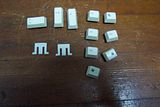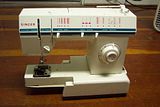
I got this keyboard at the same time as I bought that optical mouse, and it was of a similar cheapness. It broke (or I broke it; I don't remember now), and I set it aside, halfway intending to try to fix it. And there it sat for well over a year, until this Fall when they had an electronic waste collection drive on campus. And so I decided I might as well just get rid of it (again, space is very much at a premium), but not before I grabbed a couple of trophy parts.

I'm not entirely sure why I took this picture, other than to show the little height adjuster thing there.

The exception to not bothering with keyboard keys are the non-square ones, which are less common, and for some reason I think of them as more useful.











